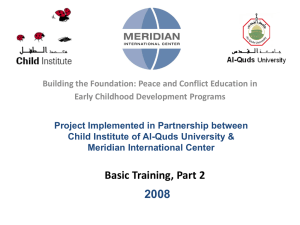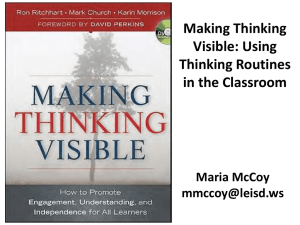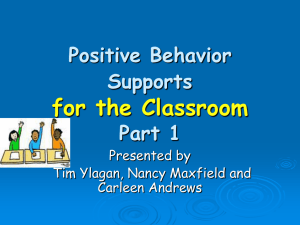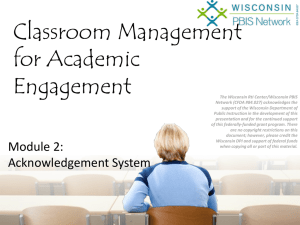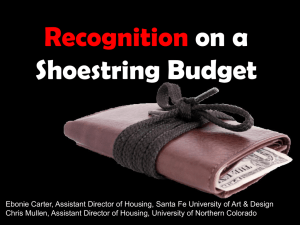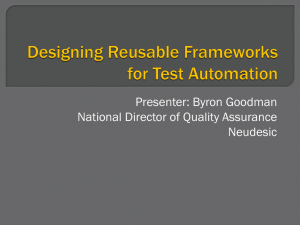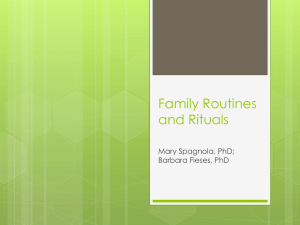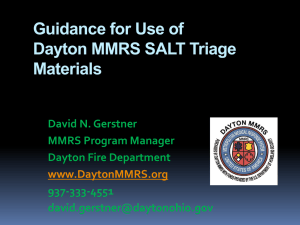CM Bootcamp for New Teachers
advertisement
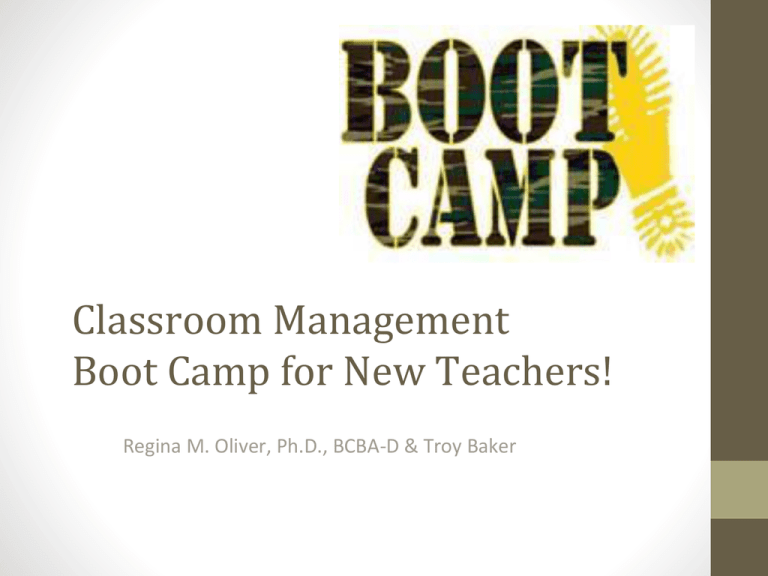
Classroom Management Boot Camp for New Teachers! Regina M. Oliver, Ph.D., BCBA-D & Troy Baker Advanced Organizer • Positive Behavior Interventions and Supports (PBIS) and Behavior Intervention Support Teams (BIST) Overview • Why is Classroom Management Important? • Effective Classroom Management • Principles of Behavior • Student-Teacher Relationships • How to Access Help in your Building BIST Main Components Behavioral Intervention Support Team 2 School-wide Rules 3 Life Skills Grace and Accountability Early Intervention Triage 2 School-wide Rules It’s never OK to be disruptive. It’s never OK to be hurtful. Three Life Skills I can have an uncomfortable feeling and not get in trouble. I can be OK even if others are not. I can do something even when I don’t want to. What students need to change: Grace and Accountability Grace is: Giving Responsibility and Accountability to Children in Education Providing what students need, “You’re too important to let you behave this way.” Having a relationship when students reject you Having the courage to hold students accountable Grace is not: Being permissive, that’s enabling Lowering standards Giving more chances Rigid, but there are clear boundaries Accountability is: Guiding students to look at what problem the behaviors create in the students’ lives and how they can develop the 3 life skills Providing consequences to protect them and a plan to practice missing skills Waiting for students to partner with adults Accountability is not: Using anger to get to compliance Punishing students Withholding attention, the relationship is a means to accountability Lecturing kids The 5 Steps to Accountability: I did it. I’m sorry. It’s part of a problem in my life. I accept the consequences. I accept and need help. Four Questions the Adult Community Must Answer What does the student’s repetitious behavior tell us s/he can’t manage? What restrictions does s/he need based on what s/he can’t manage? What skill do we need to teach them while s/he is restricted? What will the integration process from restrictions to no restrictions look like? Discussion Questions How do you feel about GRACE and ACCOUNTABILITY? What information do you need? Do you feel that the students can reach all 5 Steps to Accountability? What are the purposes of restrictions? What should restrictions look like at Everett? What shouldn’t they look like? Early Intervention Stop the behavior when you see it, don’t wait until you feel it. Be intrusive Deal with “Gateway Behaviors” What good classroom managers do all the time (proximity, the evil eye, etc.) Gateway Behaviors What are the gateway behaviors that you see in your classroom? On the playground? In the hallways? In the cafeteria? What classroom management techniques do you use to stop them? Three Levels of Triage Building level Classroom level Individual or small group Building Triage Arrange supervision so every child is greeted. The best way to keep problems out of the building is through personal contact. Classroom Triage A quick glance at the class. Teachers already do this, but we need to be consistent and intentional. It takes 5-7 minutes Be sure to include a way to know how students are doing emotionally. Individual Triage Designed as a proactive measure to meet individual student needs. Increase relationships for student within the building. Develop student’s skills to identify feelings and problem-solve. Can be prior to the start of the day and/or throughout the day. Caring Confrontation What do you think of when you hear the word confrontation? Confrontation is frequently associated with negative emotions Never confront with anger We want to use language that will allow the student to partner with us as we strive towards change and growth. Caring Confrontation Use phrases that focus on the student “I see… (disruptive behavior)” “Can you… (desired behavior)” “Even though… (student’s feeling)” Practice these at your table… Placement Continuum Regular Seat Safe Seat Buddy Room Recovery Office Home DECIDE WHERE THEY GO BASED ON WHERE THE ACTING OUT STOPS. Processing Build relationship--”How are you?” Find out what happened-- “Can you tell me what happened?” Identify the missing skill-- “Sounds like you weren’t OK when...” Validate-- “I would be mad too if…” Connect the feeling to the behavior-- “What did you do when you were mad?” Set standard and goal-- “At this school it’s never going to be OK to …” Plan to manage the missing skill--”Next time you’re mad, what will you say/do? Where will you go? Who will you talk to?” Practice Guide an Apology & Restitution Processing Processing always goes back to the 3 Life Skills: I can have an uncomfortable feeling and not get in trouble. I can be OK even if others are not. I can do something even when I don’t want to. How students move through the continuum… Moving to the safe seat Moving to the buddy room Moving to recovery (what and where is recovery) Key is Building Relationships with Students We do this through: Triage Closure for students (handshake, goodbye, high five, hug, etc) What else? Brainstorm and share ways that you build relationships in your classroom. What is PBiS? The purpose of sch ● STUDENTS • 5% • 5-10% • 80-90% PBiS is not... ➢a specific practice or curriculum…it’s a general approach to preventing problem behavior ➢limited to any particular group of students…it is for all students ➢new…its based on long history of behavioral practices & effective instructional design & strategies Three Tier Prevention Model Logic •Primary/Universal interventions implemented with ALL to prevent inappropriate behavior •Secondary/Targeted interventions implemented with SOME to reverse inappropriate behavior patterns •Tertiary/Individualized interventions implemented with a FEW to reduce harmful effects of severe behavior Multi-Tiered Systems of Support Academic Systems Behavioral Systems Intensive, Individual Interventions •Individual Students •Assessment-based •High Intensity 1-5% Targeted Group Interventions •Some students (at-risk) •High efficiency •Rapid response Universal Interventions •All students •Preventive, proactive 5-10% 80-90% 1-5% Intensive, Individual Interventions •Individual Students •Assessment-based •Intense, durable procedures 5-10% Targeted Group Interventions •Some students (at-risk) •High efficiency •Rapid response 80-90% Universal Interventions •All settings, all students •Preventive, proactive CLASSROOM MANAGEMENT Why is Classroom Management Important? • Single most common request for assistance from teachers is related to behavior and classroom management (Rose & Gallup, 2005) • School discipline issues such as disruptive classroom behavior increase teacher stress and burnout (Burke, Greenglass, & Schwarzer, 1996; Smith & Smith, 1996) • One of the top reasons teachers leave the profession Insufficient Classroom Management Competencies • Higher rates of discipline problems in the classroom (Berliner, 1986; Espin & Yell, 1994) • Lost instructional time and decreased academic engagement (Gunter et al., 1993) • Teachers find it more challenging to meet the instructional demands of the classroom (Emmer & Stough, 2001) • Teachers will be less effective in improving student outcomes in academics (Tooke, 1997) Prevention Efforts • Children’s behavior is shaped by the social context of the environment during the developmental process • The progression and malleability of maladaptive behavior is affected by classroom management practices of teachers in the early grades (Greer-Chase et al., 2002) • Aggressive students in aggressive, disruptive classroom environments are more likely to be aggressive in later grades (Greer-Chase et al., 2002) Apply the 3-Tiered Model to Your Classroom Effective Classroom Management Plans • • • • • • • Daily Schedule Physical Organization Class Rules Class Routines Managing Student Work Accommodating Diversity Collecting Data and Adjusting Plan Evidence Based Practices in Classroom Management 1. Maximize structure 2. Post, Teach, Review, Monitor, and reinforce a small number of positively stated expectations 3. Actively engage students in observable ways. 4. Establish a continuum of strategies to acknowledge appropriate behavior 5. Establish a continuum of strategies to respond to inappropriate behavior. (Simonsen, Fairbanks, Briesch, Myers, & Sugai, 2008) 1. Maximize structure in your classroom • Develop Predictable Routines • Teacher routines: volunteers, communications, movement, planning, grading, etc. • Student routines: personal needs, transitions, working in groups, independent work, instruction, getting, materials, homework, etc. • Design environment to (a) elicit appropriate behavior and (b) minimize crowding and distraction: • • • • Arrange furniture to allow easy traffic flow. Ensure adequate supervision of all areas. Designate staff & student areas. Seating arrangements (groups, carpet, etc.) Classroom Physical Arrangement • Visibility • Teacher see students at all times • Students see teacher, instructional materials, and displays • Accessibility • Teacher movement and access to all students • Students and teacher easily access materials • Keep high traffic areas free of congestion • Distractibility • Students seated away from obvious distractors • Separate disruptive students Evertson & Harris (2003) 2. Post, Teach, Review, Monitor, and reinforce a small number of positively stated expectations. •Establish behavioral expectations/rules. •Teach rules in context of routines. •Prompt or remind students of rule prior to entering natural context. •Monitor students’ behavior in natural context & provide specific feedback. •Evaluate effect of instruction - review data, make decisions, & follow up. A Little Clarification About Expectations and Rules… SW Expectations Class Expectations Classroom Rules (Behavioral Examples of Expectations) CHAMPS helps with this Expectations for Routines Establishing Expectations Expectations/Rules • expected norms of behavior • Function: to prevent or encourage certain behaviors • Rules are limited in number and do not change Routines • ways of getting classroom activities completed • Function: to establish routines for predictability, reducing problem behavior, and saving time • Procedures are unlimited in number and may change Classroom Expectations vs. Classroom Rules • Expectations: behaviors expected of all students and staff in all settings • Rules: specific skills you want students to exhibit and the procedures you want students to follow in specific settings Similarities Between Expectations and Rules • Both should be positively stated – tell students what you want them to do • Both should be limited in number • Both should line up with your school’s school-wide expectations • Both will clarify criteria for success Rules within Routines Matrix Routines Entering Classroom Expectations Be Safe Be Respectful Be Responsible • Rules Seat Work Small Group Activity Leaving Classroom Develop a Plan for Teaching Students to Engage in Routines Conversation: How much & what type? Help: How do they let you know they need it? Activity: What is it? How long should it take? Movement: How and when can students move? Participation: How will students be active and show engagement? onversation • What does it sound like? • Can they engage in conversations? • How loud? How will you judge this? (Zone system?) elp • • • • • Hand Signal (1 finger, 2 fingers, 3 fingers) Colored toilet paper tube (red and green) Styrofoam cup on a string Flags on the desk Cardstock pyramid: “Please help me” and “Please keep working” • Stand up your textbook • Post-It for Help • “Red Folder” of alternative work Tip: Students always continue to work while waiting ctivityovemen t articipation • What does it look like? Teach Rules in the Context of Routines • Teach expectations directly. • Define rule in operational terms—tell students what the rule looks like within routine. • Provide students with examples and non-examples of rule-following within routine. • Actively involve students in lesson—game, role-play, etc. to check for their understanding. • Provide opportunities to practice rule following behavior in the natural setting. Teaching Your Rules and Routines • Explanation • Define in concrete terms • Rationale • Demonstrate/Model: examples & nonexamples • Rehearsal • Practice • Determine if re-teaching is necessary • Feedback • Specific praise • Error correction • Reteach Lesson Plan NAME OF RULE Students will use a question card when they need my help during independent work time. ROUTINE Students will be taught how to use a question card during independent work time. OPERATIONAL DEFINITION OF EXPECTED BEHAVIOR WITHIN SPECIFIC ROUTINE When students need my help during independent work time they will flip there question card up on their desk. This signals to me that they have a question while I am circulating around the room. Students will be taught to skip that problem and work on another problem until I can get over to them to answer their question. p.1 Lesson Plan POSITIVE EXAMPLES Student flips up question card and continues working on another problem. NEGATIVE EXAMPLES Student flips up question card but does not continue working. Student blurts out question instead of using question card. PRACTICE OR ROLE PLAY ACTIVITIES Students will practice using question card. Students will blurt out answer and I will prompt them to use the question card. WAYS TO PROMPT EXPECTED BEHAVIOR Go over to student and point to question card. Quietly remind student to use question card. Respond to students who use question card. p.2 Social Skills Lesson Plan PROCEDURES FOR MONITORING STUDENT BEHAVIOR Number of times students use the question card. Number of times students blurt out question or get out of their seat. PROCEDURES FOR RECOGNIZING APPROPRIATE BEHAVIOR Positive praise: thank you for using the question card. Responding to students that use question card. PROCEDURES FOR CORRECTING INAPPROPRIATE BEHAVIOR Quietly reminding student to use question card. Responding quickly to students that use the question card. For some students this might be a quick touch (John I see you have a question, I will be right there. Remember to go on to the next problem). p.3 3. Actively engage students in observable ways. ● Provide high rates of opportunities to respond – Vary individual v. group responding – Increase participatory instruction (enthusiasm, laughter) ● ● Consider various observable ways to engage students – Written responses – Writing on individual white boards – Choral responding – Gestures – Other: ____________ Link engagement with outcome objectives (set goals to increase engagement and assess student change) Range of evidence based practices that promote active engagement ● Direct Instruction ● Computer Assisted Instruction ● Class-wide Peer Tutoring ● Guided notes ● Response Cards 4. Establish a continuum of strategies to acknowledge appropriate behavior. •Specific and Contingent Praise •Group Contingencies •Behavior Contracts •Token Economies Specific and Contingent Praise •Praise should be… • …contingent: occur immediately following desired behavior • …specific: tell learner exactly what they are doing correctly and continue to do in the future • “Good job” (not very specific) • “I like how you are showing me active listening by having quiet hands and feet and eyes on me” (specific) Praise Guidelines(Source: Reavis, Kukic, Jensen, Morgan, Andrews, Fister, 1997) I-Feed-V I = immediate F = frequent E = enthusiasm E = eye contact (?) D = describe the behavior V = variety 4:1 STUDENT-TEACHER RELATIONSHIPS What Does 4 Positives to 1 Negative Mean? • Students should experience more positive interactions (ratio of 4 positives for every negative) on all locations of school. • Positive Interactions= • Behaviorally specific feedback as to what the student did right (contingent) • Smile, nod, wink, greeting, attention, hand shake, high five (non-contingent) • Negative Interactions= • Non-specific behavioral corrections • Ignoring student behavior (appropriate or inappropriate) Examples • • • • • • • • • • • High Fives, Gotchas Traveling Passport Super Sub Slips, Bus Bucks Back/front of bus Free homework coupon Discount school store, grab bag Early dismissal/Late arrival First/last in Line Coupon to store or restaurant Positive Office Referrals Extra dessert 1-Free Period File stuffer Coffee Coupon Golden Plunger Give Em’ a Hand Kudos Success is more likely in the longer term when…. Prevention creates more positive than negative consequences Adults may need a tangible tool for monitoring ratios of praise to reprimands How to Access Help! • • • • • PBIS coach (1 x week) School Psychologist BIST Consultant (1 x month) SAT process Special Education
